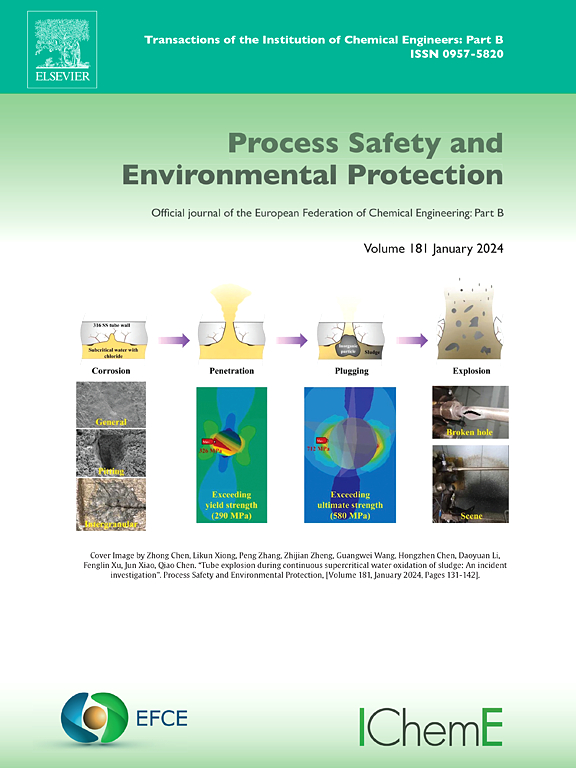不同触发位置下锂离子电池模组热失控传播的实验研究
IF 6.9
2区 环境科学与生态学
Q1 ENGINEERING, CHEMICAL
引用次数: 0
摘要
锂离子电池(LIB)模块由众多单个电池组成,触发热失控(TR)的位置对热失控传播(TRP)起着至关重要的影响作用。然而,人们对热失控触发位置对 LIB 模块内热失控传播的影响仍然了解不足。这项研究调查了镍钴锰酸锂(NCM523)和磷酸铁锂(LFP)电池模块中 TR 触发器位置对 TRP 的影响。我们的研究结果表明,将触发器位置从角落移到中心可将 NCM523(LFP)模块的 TRP 率从 0.365 (0.244) 格/分钟提高到 2.270 (0.685) 格/分钟。此外,NCM523 (LFP) 模块的能量利用率也从 31.3% (28.9%) 提高到 56.1% (46.5%)。本文使用扫描电子显微镜-能量色散光谱法进一步分析了从 LIB 喷出的微粒物质。最后,本文提出了一个危害评估模型,以评估不同触发位置下与锂电池模块相关的风险。结果表明,将触发位置从角落过渡到中心会加剧锂电池模块的相关危害。本研究系统地阐明了阴极材料和触发位置对 TRP 的影响,为电动汽车模块的安全管理和设计提供了明确的指导。本文章由计算机程序翻译,如有差异,请以英文原文为准。
Experimental investigation on thermal runaway propagation of lithium-ion battery module under different trigger locations
The Li-ion battery (LIB) module is composed of numerous individual cells, and the locations at which thermal runaway (TR) is triggered play a crucial role in influencing thermal runaway propagation (TRP). Nevertheless, the impact of the TR trigger location on TRP within LIB modules remains inadequately understood. This work investigates the influence of the TR trigger locations location on TRP in both LiNi0.5Co0.2Mn0.3O2 (NCM523) and LiFePO4 (LFP) battery modules. Our findings demonstrate that relocating the trigger location from the corner to the center increases the TRP rate of the NCM523 (LFP) module from 0.365 (0.244) to 2.270 (0.685) cell/min. Additionally, the energy utilization rate of the NCM523 (LFP) module rises from 31.3 % (28.9 %) to 56.1 % (46.5 %). The ejected particulate matter from LIBs is further analyzed using scanning electron microscopy-energy dispersive spectroscopy. Finally, this paper proposes a hazard assessment model to evaluate the risks associated with LIB modules under different trigger locations. The results indicate that transitioning the trigger location from the corner to the center exacerbates the hazards associated with LIB modules. This study systematically elucidates the impact of cathode materials and trigger locations on TRP, offering definitive guidance for the safety management and design of electric vehicle modules.
求助全文
通过发布文献求助,成功后即可免费获取论文全文。
去求助
来源期刊

Process Safety and Environmental Protection
环境科学-工程:化工
CiteScore
11.40
自引率
15.40%
发文量
929
审稿时长
8.0 months
期刊介绍:
The Process Safety and Environmental Protection (PSEP) journal is a leading international publication that focuses on the publication of high-quality, original research papers in the field of engineering, specifically those related to the safety of industrial processes and environmental protection. The journal encourages submissions that present new developments in safety and environmental aspects, particularly those that show how research findings can be applied in process engineering design and practice.
PSEP is particularly interested in research that brings fresh perspectives to established engineering principles, identifies unsolved problems, or suggests directions for future research. The journal also values contributions that push the boundaries of traditional engineering and welcomes multidisciplinary papers.
PSEP's articles are abstracted and indexed by a range of databases and services, which helps to ensure that the journal's research is accessible and recognized in the academic and professional communities. These databases include ANTE, Chemical Abstracts, Chemical Hazards in Industry, Current Contents, Elsevier Engineering Information database, Pascal Francis, Web of Science, Scopus, Engineering Information Database EnCompass LIT (Elsevier), and INSPEC. This wide coverage facilitates the dissemination of the journal's content to a global audience interested in process safety and environmental engineering.
 求助内容:
求助内容: 应助结果提醒方式:
应助结果提醒方式:


